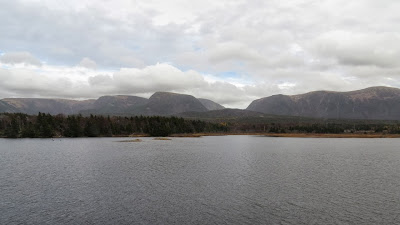Birded the famous, but under birded, Grand Codroy Valley today in Southwestern Newfoundland. This was my first time visiting the area so I tried to cover all areas in an effort to become familiar with all the area knowing that the new-formed mental map will help me on future visits.
I got dropped off at the north side of the estuary with my bike at 7am, and continued North to Cape Anguille where there was an amazing seabird flight. Gulls were cruising down the coast just above the short cliff allowing great looks from less than 50m away. Several Iceland Gulls were amongst the hundreds of Herring Gulls - a clear sign that they've flooded in during the last few days, as I've only seen singles so far this season. Seabirds were not too far off either - most were flying South less than 100m from my observation point, including: 15 Black Scoter, & 24 Harlequin Ducks! The best part though was having 8 Red-throated Loons fly by throughout the sea watch - a good opportunity to become more familiar with this uncommon species.
 |
| Always love a good seawatch next to a lighthouse |
I was struggling to convince myself to leave the seawatch after only an hour in favour of getting to the valley where there was promise of several thousand waterfowl. I eventually did tear myself away and got to the Codroy Valley Provincial Park - which forms a barrier between the estuary and the ocean. This is where I got my first flavour of the high concentration of waterfowl in the area.
 |
| Codroy Valley Provincial Park - a tiny park! |
Any goose other than Canada Goose was high on my wish list. I thoroughly checked all 1200+ CANG that I came across without finding an odd one out.
 |
| Not often seen on the island: a large concentration of waterfowl |
In the afternoon I returned to the park after looping around the valley. Not long after I arrived I noticed a small gull flying towards the ocean. I quickly put my scope on it expecting to tick Black-headed Gull for the day. As soon as I saw it I was confused - the bird definitely did not fit for BHGU, it seemed small, had a lot more black on the underwing, and absolutely no black on the upperwing. For some reason it took me a while to consider Little Gull - a less than annual vagrant in the province that I obviously didn't have on my radar for this weekend. Once the species came to mind everything fit. I could have taken photos - but I decided to study the bird for the 15-20 seconds that it was in my presence before it flew out to sea.
Mountains with peaks of over 1500ft can be seen inland from the valley:
The second main highlight of the day came just before sunrise at a totally unexpected spot. Google maps led me to believe that there was a paved road on the South side of the Little Codroy valley - but there wasn't, which probably explains why very few (or no) birders have checked out this side of the valley. I followed googles route anyway and made it to a park that is very similar to the Codroy Valley Provincial Park. This park, Mummichog PP, divides the Little Codroy river from the ocean in much the same way that the Codroy Valley PP divides the Grand Codroy river from the ocean.
Oddly, there was very few waterfowl in the Little Codroy valley; however, there were plenty of seaducks just beyond the park and were quite visible from a spot called Shoal Point:
From this observation point I counted 220 Black Scoter, 52 Red-necked Grebe, & 3 Harlequin Ducks. The Black Scoter and Red-necked Grebe counts could be all-time high counts for the island! I definitely was not expecting this concentration here.
Pics of the main Black Scoter flock
 |
| There's 180 in this flock alone! |
Check out this poorly edited video of the scoters and Harlequin Ducks (best if you go to the actual Youtube page and put it at the highest quality and full screen...):
'til next time





























